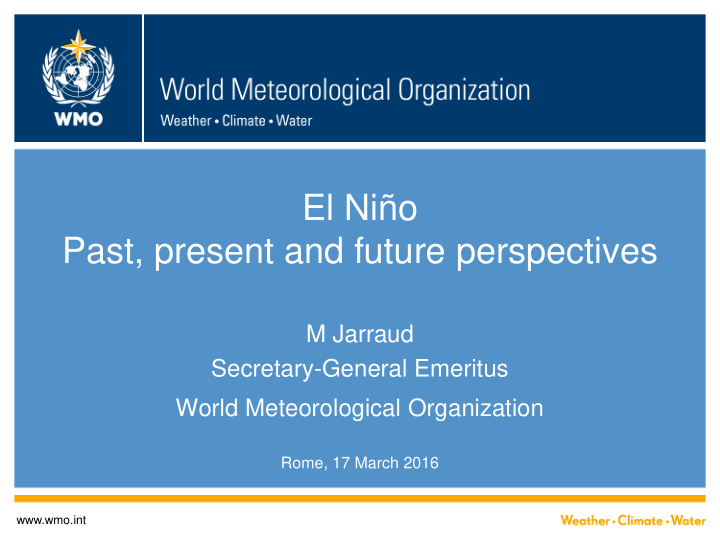



El Niño Past, present and future perspectives M Jarraud Secretary-General Emeritus World Meteorological Organization Rome, 17 March 2016 www.wmo.int
El Niño: Much ado El Niño (1997) about something Largest component of internal climate variability Global impacts Major actor in human La Niña (1988) history Significant progress in understanding and prediction , but… Important remaining questions! 2
El Niño: a brief history of time Fishing off the coast of Peru • Observed for many centuries with failures of fish catch • Often near Christmas • El Niño • At the same time… Droughts in China and Africa Failure of monsoon in India As a result, tens of millions died from famine 3
El Niño and Southern Oscillation: ENSO El Niño: Ocean component of ENSO Southern Oscillation: atmospheric component of ENSO Connection discovered in 1960s-1970s Intensive observation campaigns and research (1980s-1990s) significantly improved predictive skill (1990s-2000s) 4
ENSO: Current state of knowledge Increased convection Equator Thermocline 120 ° E 60 ° W El Niño 5
ENSO: Current state of knowledge Strong convection Equator Cold upwelling Thermocline 120 ° E 60 ° W La Niña 6
Zimbabwe Chennai-India Peru Indonesia 7
El Niño: Impacts December-February Warm Warm Wet Wet and cold Wet Warm Dry Wet Dry Dry and warm Wet and warm Warm Dry and warm Warm Wet 8
EL Niño: Impacts June-August Dry Dry and warm Dry Wet Warm Warm Dry and cold Wet 9
ENSO: Impacts More hurricanes Fewer hurricanes Warm and wet Also: • Global temperature • Sea level 10
Global surface temperature anomalies 1950-2015 1950 1960 1970 1980 1990 2000 2010 11
ENSO: Impacts Can affect tens of million people Increased frequency of extreme events (droughts, floods, fires …) Food security (severe reduction or even total loss of harvest, need to slaughter cattle …) Health (diseases transmitted by insects, or linked to quality of water or air pollution …) Energy production (in particular hydro power) Environment (coral bleaching …) Economic losses attributed to 1997-98 El Niño: 30 to 100 billions $. Direct setback to sustainable development 12
Weather-to-climate: seamless framework Centuries Forecast Scenarios uncertainty Decades Forecast lead time Years Outlooks Seasons Climate scenarios Guidance Months and projections 2 Weeks Threat assessment Climate predictions 1 Week Forecasts Days Watches Hours Weather forecasting Warnings and Minutes alert coordination Socioeconomic benefits Adapted from NOAA 2011 13
Skill of SST Forecast for J F M from North America Multi-Model Ensemble (NMME) LOW SKILL MEDIUM HIGH SKILL SKILL CorrelaEon (x10)
ENSO predictions 15
Regional climate outlooks and climate services Consensus Climate Outlook for Projected food security outcomes, September to December 2015 October to December 2015 16 Food Security Outlook for Horn of Africa based on seasonal forecast
Probabilistic El Niño forecast – 11 February 2016 17
The future Further investments in observation and research (including social sciences) Capacity development Climate change and ENSO Further development of climate services (GFCS), in close cooperation with all relevant partners and stakeholders. Need for stronger 2 ways communication Need for strengthened regional cooperation Need for more systematic socio economic impact studies 18
Stakeholder engagement Effective engagement of various stakeholders essential to the implementation of GFCS Definition of principles allowing future designation of activities implemented by various stakeholders as contributing to GFCS 19
GFCS is a partnership Weather • Climate • Water 20
However … ENSO is a normal part Mummy, it’s El of climate system Niño Not every weather or climate anomaly can be attributed to El Niño Link with climate change still unclear Forecasting ENSO different from forecasting its impacts (after M Glantz – 2000) 21
اركش Gracias 谢谢 Merci Thank you Thank you спасибо www.wmo.int Weather • Climate • Water 22
Current ENSO 23
ENSO: Current state of knowledge Precise definition difficult Every 2 to 10 years No two ENSO are identical Significant historical variability (over last 10 to 20 000 years), derived from: • Pollens, corals, sediments, tree rings, … 24
From observations to prediction 25
Space-based component of the Global Observing System 26
From observations to prediction Over 3600 ARGO floats 27
Forecasts of the 1997-98 El Niño Made June 1997 From the Experimental Long-Lead Forecast Bulletin (COLA) Made September 1997 Made March 1997
Global surface temperature anomalies 1880-2015 over 5 and 10 years 10-year anomaly 1880 1900 1920 1940 1960 1980 2000 2020 5-year anomaly 1880 1900 1920 1940 1960 1980 2000 2020 29
Recommend
More recommend